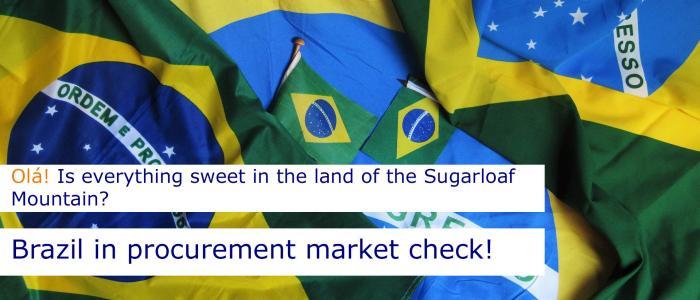Procurement market Brazil: Is everything sweet in the land of the Sugarloaf Mountain?
This time we focus on the South American country Brazil in our procurement market check. We will show you the potentials of this country and you can make yourself an overview! Part 6 of our series.
Procurement in Brazil
Brazil experienced a very sharp drop in GDP in 2015 (3.6 percent) and 2016 (3.5 percent): the country’s biggest recession. With currently about 207.68 million people, a GDP of 2,054.97 billion US dollars and a GDP per capita of 9,894.93 US dollars, the country seems to recover again. Brazil has the largest economy in Latin America and is eighth in the world.
Brazil’s industrial development is based on mechanical and automotive engineering as well as on the chemical and electrical engineering industry. In addition to these industries, the consumer goods industry, the production and processing of food as well as the building materials and paper industry play an important role in development.
The center of Brazilian industry is São Paulo. The most populous and economically most important part of the 27 Brazilian states contributes about one third of Brazil’s total production. In addition to São Paulo, the cities of Rio de Janeiro, Belo Horizonte, Porto Alegre and Fortaleza are also important locations that shape the industry. Since 1994 Brazil’s currency has been the Real as a result of high inflation rates.
Last year, goods worth $ 157.7 billion were imported to Brazil. Among the major importing countries of Brazil is in fourth place Germany with 6.6 percent, in third place Argentina with 6.7 percent, in second place with 16.9 percent the United States and in first place with 17.6 percent China. There is hardly any difference between the export countries and the top import countries. In fourth place is the Netherlands with 5.6 percent. In third place, just like in the import ranking is Argentina with 7.3 percent, in second place the USA with 12.6 percent and in first place China with 19 percent. In 2016, goods amounting to $ 217.8 billion were exported.
Trading partners – Brazil and Germany
Brazil is Germany’s most important trading partner in Latin America. Especially iron ore, soy and soy products, coffee, car parts, machinery, meat, copper and crude oil are imported to Germany. The exports from Germany to Brazil include machinery, cars as well as car parts, pharmaceutical products, electrical engineering and metal goods. In addition, Brazil is the ninth most important overseas market of the German neighboring country Austria.
Olá raw materials
Important economic factors include the agro- and commodity sector. Brazil has many resources. In addition to the world’s largest coffee production and orange harvest, iron and iron ore are for example also included and partially exported to other countries. The country is the world’s largest iron supplier. But also in the field of gemstones Brazil has a very good position. Around 60 percent of all processed gemstones come from the South American country. Besides that, around 1.5 million barrels of crude oil are extracted every day.
Large companies of Brazil
Brazil’s largest companies include several oil and gas companies such as Petrobras, headquartered in Rio de Janeiro, with sales of $ 74,012.5 million and Petróleo Ipiranga, with sales of $ 13,740.2 million and headquarters in Porto Alegre. But also companies from other sectors are among the top companies, such as Vale do Rio from the mining industry based in Rio de Janeiro with a turnover of 21,183.8 million US dollars.
Conclusion
Brazil offers many opportunities for today’s procurement of European companies. Especially for companies in the industrial and consumer goods industry, Brazil could develop into an interesting trading partner with a lot of potential. Also worth mentioning are the current talks on a free trade agreement between the EU and the Confederation Mercosur (Argentina, Brazil, Paraguay and Uruguay). This could eliminate 90 percent of tariffs in the future.
About the author:
Osman Cetinkaya
Osman Cetinkaya is a Senior Partner at Kloepfel Consulting. During his studies of business administration, he gained his first consulting experience in the field of process optimization / quality management. Afterwards, he deepened his consulting expertise for several years with an international management consultancy. As a result, he switched to the line function in the trading environment and shaped the still young teleshopping industry in various management functions for more than 10 years.
Would you also like to benefit from the know-how of our experts? Then feel free to contact us at +49 211 875 453 23 or at info@kloepfel-consulting.com.
Part 1: Procurement market Russia – The host country of the World Cup in the check
Part 2: Procurement Market Mexico – More than just Siesta!
Part 3: Procurement market Sweden – How strong is our preliminary round opponent?
Part 4: Procurement market South Korea – The opponent of the World Cup in the check
Part 5: Procurement market Switzerland – Our neighboring country in check



Comments are closed.